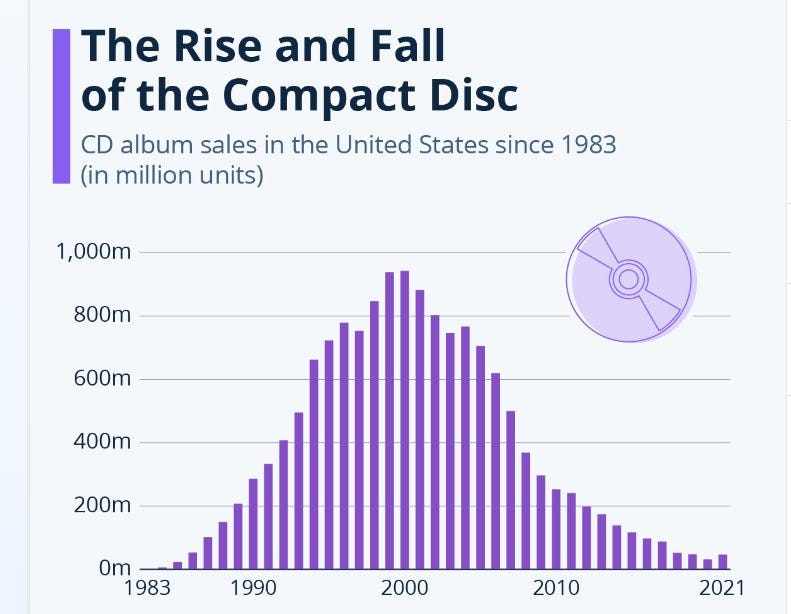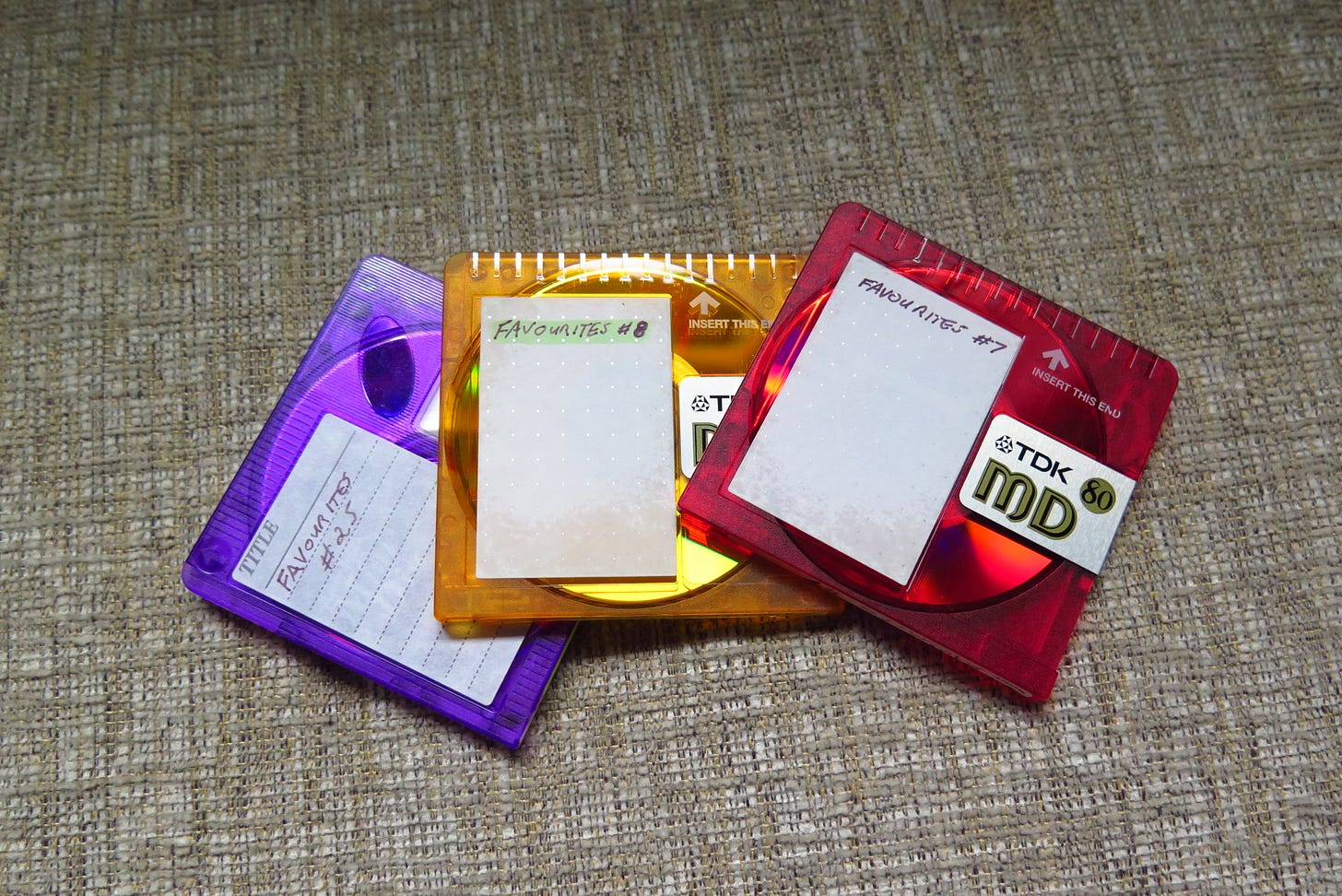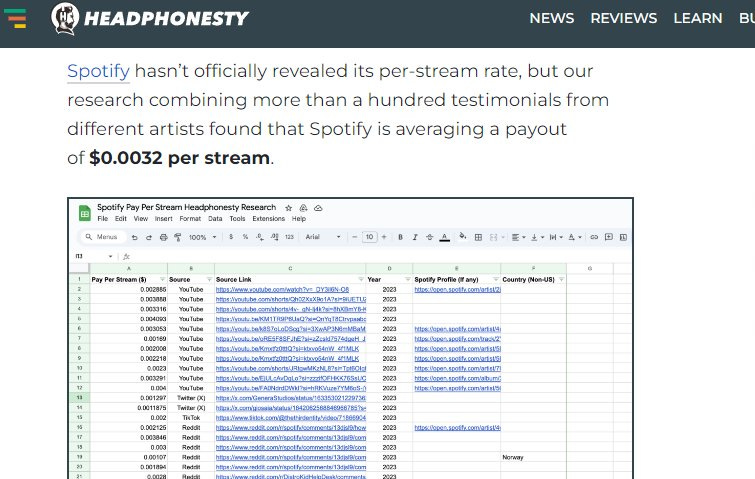The Day the Music Died - (side 3)
How the early 21st century digitised and consequently devalued musical creativity
(Note to the reader: this post might be too long for an e-mail notification, so in that case it might be better to open it in the Substack app or in a new window on a PC)
Part 3 – “I Want My mp3...”

(Part 2 can be seen here)
As described in Part 1, there were in my opinion two further very significant developments that came of age in the last decade of the 20th century and the early part of the new millennium.
The first was the music compression system mp3, and the second the advent of the worldwide web as a consumer-level communication, information and entertainment medium.
“I want it all…I want it now..”
Although mp3 software to compress, store and play existing physical CD music on an individual level at home on a computer was available through downloadable applications from the mid- '90s, the quantum leap in its adoption as a de facto standard - for portable music at least - was the ability to share files on a peer-to-peer basis. Every picture tells a story, as a young cockerel-coiffed Rod sang.
(Source : Statista/RIAA)
That sharp and consistent drop-off in CD sales after 2000 coincides with availability of this new technology. And of course we all know the story about the early days of peer-to-peer file sharing. Napster; lawsuits; well-publicised prosecutions; Digital Rights Management System to prevent copying of CDs with a view to pirating and mass-distributing “free” copies to whoever had an internet link and a modem.
As a bolt-on to this, it’s worth mentioning in passing that some content creators have argued that this was not really anything new; as from the days of audio cassettes, people were able to use twin decks to create copies of commercial recordings and distribute these either free or for sale. And that this was a serious problem for the music business in the 1970s and ‘80s. Well, while anyone of that vintage will remember the skull-and-crossbones warnings printed on the inner sleeves of albums that “home taping is killing music” , these commentators seem to overlook the fact that this was by its nature a pretty laborious process.
Copying was mostly only possible in real time on domestic equipment to get any sort of reasonable quality. I would argue that spending about an hour creating a single cassette copy (or a vinyl-to-tape copy) was never going to pose a substantial threat to the vinyl pressing plants, and the whole thing was wildly exaggerated. There were professional double-speed copying machines as far as I recall, but I was never offered any of these professional copies and would question the extent of the practice.
In my circle of musical friends, we would record the odd LP to a cassette for a friend, and they might do similar for me. But if I really liked the album, I would just go and buy it, as the sound quality was a lot better, and you got all the artwork and sleeve notes. That went for most people I knew. A cassette was a good option for the car or Walkman and that was mostly the extent of it.
But back to file-sharing. There was no going back, and as always, the technology giants soon identified The Next Big Thing and acted swiftly. Enter Apple and the iPOD. And to set up their own licensed music store as a go-to for all iPOD users who want to build their collection (again) was pretty ingenious if you ask me.
Thinking about it, there had been no serious development in the niche of “portable music” since the Sony Walkman more than twenty years before, so it was long overdue. Okay, there had been a half-hearted effort with the “portable CD player”. They were pretty funny. Take a medium which really isn't particularly portable in itself, and develop a device to attempt to make it portable. Sort of. Just don't make any sudden moves, like jogging or even walking.
To put the impact of the Sony Walkman on popular culture in perspective: “portable musical entertainment” went from this…..

…to this. Pretty bloody amazing. I was there and I remember.

Also, to be fair, the Minidisc from Sony needs a very honourable mention. It made much more impression in the Japanese market than elsewhere for some reason, probably to do with Sony having a lot more muscle in marketing and distribution than elsewhere. And it could be that if the technology had been in-market in the US and Europe a couple of years sooner, or the iPOD a couple of years later, it would not have been such an also-ran.
A shame, since on a personal level, I love Minidisc, and I still have several domestic and portable players which I use. There was also a large take-up by the likes of radio stations for things like adverts and station ID jingles. A logical successor to the cartridges in use before, and more resilient and editable.
It's noteworthy that the ATRAC software (Adaptive Transform Acoustic Coding - I knew you were desperate to ask) had a unique selling point in that live analogue-to-digital recordings could be made in addition to straight digital copies of mp3 files. So it was a perfect way of getting treasured vinyl recordings into the more convenient and truly portable format. Plus...they just look so cool!
All of which I appreciate would mean zippo to the average music fan of the early 21st century, who would have been pretty much a stranger to vinyl and tape, and primed and ready for the most ultra-convenient way ever devised to both purchase and enjoy his music. Wherever he happened to be.
So to return to the subject in hand…..the Walkman now finally had its logical successor, and the entertainment industry was about to have another exciting if not revolutionary technological refresh; in the shape of the era-defining iPOD.

I managed to find this advert from the time. Worth a look.
Furniture Music
OK. Here's my take on why this was arguably a watershed moment in the downward spiral of popular music as an artform. It just followed the same evolutionary curve of most other aspects of our culture (for example e-books and readers, digital photography), and became convenience-led. With every gain comes a corresponding loss, in so many things. Okay, maybe not everything. I don’t find myself wondering what experiencing diphtheria might have been like… but you get the gist.
Now, I know this is all contentious, which is fine. And I know that generalisation is an unsatisfactory approach for a complex discussion. But I would say that there is at least some validity to my admittedly broad-brush arguments here. It’s just a thesis, there to be examined. As always, I welcome constructive comments below if the reader thinks I am way off beam.
Let me explain as best I can. From a young music listener perspective, she could consume, and equally easily discard, any tracks with a couple of button presses or screen swipes. The cost per track was modest in comparison to all the previous (physical) media, and this is very important in my opinion; because that absence of financial investment almost inevitably results in a corresponding absence of time investment in my opinion.
Music that had any level of nuance and complexity was (possibly and generally) not lifestyle-compatible for the newer generation of “entertainment consumers”, who were raised in a world with a rapidly growing array of amusements and diversions to spend their disposable income on. They were able to now indulge in gaming, texting, chatting and music-scrolling all at once, and wherever they happened to be. At work, on a laptop, travelling, shopping, you name it.
Don't like that track at first listen? Skip it, try another one. Find one that sounds okay straight off? Fine, that will do for now. Download, pay, enjoy while doing other stuff. Get bored after two or three listens. Repeat process.
Disposable music was the perfect solution for the multi-sensory always-on lifestyle of the early 21st century Western youth.
So maybe the technology dictated the lifestyle, and the lifestyle in turn selected its preferred soundtrack. Which was: undemanding, predictable, immediately appealing, quickly tiresome, easily and cheaply replaced.
The upshot of course was that artists who hitherto had been engaged in producing music which was for example album-based, demanding of at least a few listens to appreciate and get a full understanding of, found themselves in a very difficult position. The iPOD generation was now largely locked into the single-track three-minute, continuous-partial-attention milieu. And there was no room and no time for the old world.

“I'm Mandy ,Try Me..”
Which brings us to the latest, and possibly terminal, obstacle to any aspiring musician and songwriter who just wants to make a break-even living doing what he or she loves. This being the business model of music streaming, spearheaded by Swedish company Spotify and since joined by other big players like Apple.
An absolute wow for consumer convenience. Less so for most music creators….
(Source : headphonesty.com)
Have a look at the average per-stream royalty payment quoted above.See the problem for people who aren't Taylor Swift, Adele or AC/DC? If a smalltown band playing its own material just gets its own CDs mastered and packaged, it can be done for around £5 per unit with a nice fold-out cover. If they sell them for £10 at a gig, and conservatively sell 20 CDs, then at eight weekend gigs per month (assuming they are semi-pro only) they bank £800 minimum per month. How long do you think it would take to rack up 250,000 Spotify streams to accrue roughly the same amount? It's never going to happen of course. It's a platform that only works for the tiny percentage of megastars in a meaningful sense as a revenue source.
And extrapolating from this commercial and artistic reality: even if a small independent artist picks up some airplay on (say) a specialist radio station , there are ever fewer of these thanks to globalisation, where a tiny handful of huge media corporations own 90% of radio worldwide.
So the limitation of exposure is baked in. Consequently, the numbers still don't add up where physical music sales are concerned. The game is permanently skewed in favour of the tiny few who have the PR machine and the deep pockets to keep their product in the faces and earbuds of the masses.
As for those “legacy” artists who continue to tour many years and often decades since they produced any new material? Well, in their working lives the whole model has been turned on its head. In the 1970s and 1980s, the lavish tour was a loss leader. Get the theatres filled (more than stadia - that came later in the UK at least), preview the new material, give the fans a show and hope that they would vote with their wallets at the local record shop when the album is released, usually to coincide with the tour or just before. Nowadays for those big beasts of earlier decades who are still (or again) touring, the money is in huge arenas, eye-watering ticket prices and merchandising opportunities.
One also is forced to wonder whether the narcissism and brag-culture engendered and normalised by social media selfie video posting is as valuable to the artist as most of the merchandise on offer at the average stadium and festival gig these days. Or so it seems, going by social media when I can be bothered to log in…or for that matter by what I have to witness at the few gigs I attend these days. Even grown men who should know better, filming entire songs while watching the show ON THEIR PHONES instead of for real. While they block other people’s view without a shred of self-awareness. Kids don’t know anything else, but grown-ups….painful to witness.

So that brings us to now, at least as far as the major consumer-led trends in the music/entertainmnent industry are concerned. Of course, nothing exists and evolves in isolation, and there were major impacts for the creators and distributors, as discussed in this piece. In the final section, I will spend a little time looking in more depth at the history of that artist- and industry-led aspect of the process of the craft of popular music over the last few decades; and how that might be a significant factor itself, in the question of deteriorating quality of the finished product.
As always, comments welcome whether positive or contrary, and thanks for reading!







Some great points here, Renewable Energy. I particularly loved what you said about: "Music that had any level of nuance and complexity was (possibly and generally) not lifestyle-compatible for the newer generation of “entertainment consumers”, who were raised in a world with a rapidly growing array of amusements and diversions to spend their disposable income on. They were able to now indulge in gaming, texting, chatting and music-scrolling all at once, and wherever they happened to be. At work, on a laptop, travelling, shopping, you name it." This is a great observation as well. Paired this with the instant clickability, changeability, and easy-in easy-out mentality ... and technology had inadvertently taken away one of the most important elements of deep listenership: the ability to wait. Your writing is such a great reminder of this. I appreciate the prompting. Hope you're well this week? Cheers, -Thalia
Yes, a complete statement, from the packaging and art all the way through to the last song. Perfectly put. I am looking forward to the last part, it’s been an excellent read.